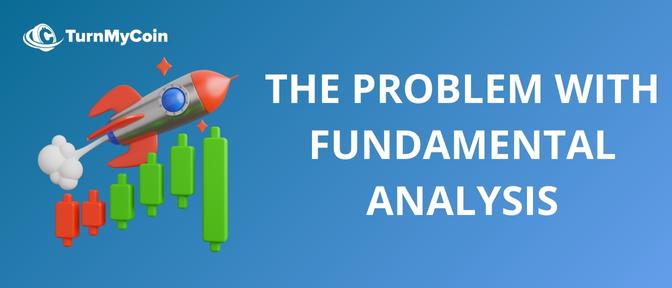Last updated on January 23rd, 2024 at 12:56 pm
Introduction
When evaluating a project and its assets, the fundamental analysis shows that crypto market has its own unique set of considerations to evaluate that are not relevant in more traditional marketplaces.
To determine if an asset is overvalued or undervalued, fundamental analysis involves establishing its true worth. You can use such data in conjunction with technical analysis to make a trading or investment decision.
When compared to traditional asset evaluation of fundamental analysis, the method used in crypto fundamental analysis is unique. Due to the lack of a consistent reporting structure for crypto assets, such as profit and loss statements, they lack the necessary historical context.
Many aspects of a cryptocurrency, including as its network, development team, vesting dates, and use cases, must be researched in order to provide a complete picture of the asset for study. Speculators can learn the true worth of a project before investing in it if they take into account the correct collection of elements.
Table of Contents
What is fundamental analysis (FA)?
Investors use fundamental analysis (FA) to determine the “intrinsic value” of a company or an asset. Their primary objective is to ascertain if the asset or business is overpriced or underpriced by considering a variety of internal and external criteria. With this knowledge, they may make informed decisions on when to enter or depart a position.
Similar to fundamental analysis, technical analysis provides useful trade data, although with a unique set of insights. Investors who rely on TA assume they can accurately forecast asset prices by analyzing their historical performance. The study of key indicators and the recognition of candlestick patterns allow for this.
In order to determine what they believe to be its true worth, traditional fundamental analysis frequently use financial data. Earnings per share (the amount of money a firm produces for every share outstanding) and the price-to-book ratio are two examples of useful metrics (how investors value the company versus its book value). This might be done for many companies in the same industry to compare and contrast potential investments.
The problem with the fundamental analysis of cryptocurrencies

In many ways, cryptocurrency networks defy the same metrics that are commonly used to evaluate more conventional enterprises. Decentralized services, such as Bitcoin (BTC), are more akin to commodities. Traditional fundamental analysis (FA) indicators, however, don’t tell us anything about even the most centralized cryptocurrencies (such as ones issued by organizations).
So, it is time to consider other conceptual frameworks. It begins with the selection of reliable measurements. Strong ones are ones that are difficult to manipulate in any way. Because of the ease with which fraudulent accounts can be created or participation can be purchased on social media platforms like Twitter or Telegram/Reddit, they are probably not useful measures.
It’s vital to keep in mind that there is no magic metric that can paint a complete picture of the network under evaluation. The number of functioning addresses on a blockchain may be tracked to reveal a meteoric rise in usage. It, however, does not teach us anything lot on its own. It’s possible that this is just one person using several addresses to send and receive money indefinitely.
Next, we’ll examine three types of crypto fundamental analysis (FA) metrics: on-chain metrics, project metrics, and financial data. Although not comprehensive, this list should serve as a solid starting point from which to develop indicators in the future.
The top 9 recommendations are as follows.
1. Check out the white paper.

Reading the white paper for a token is essential, especially if you plan to acquire it and hold it for a lengthy period of time. The document provides a well-thought-out, comprehensive summary of the project. An informative white paper will cover:
- Aims of the Work
- Distribution and examples of use
- a shared dream for the group
- The token’s underlying technology
- Development roadmaps for improvements and other features
- Explaining the utility of the token
2. Analyze the paper’s assertions

Remember that the persons in charge of a project may do anything to the truth to make it fit their agenda.
There are actually quite a few instances where this is the case. For instance, CEO and creator of Titanium Blockchain Infrastructure Services Michael Alan Stollery raised $21 million in an ICO (ICO).
Afterwards, he revealed that he had fabricated some of the project white paper.
Prior to investing money, it’s wise to gather all of the details about a project’s viability and ask any pertinent questions.
Some things to think about:
- Is the token distribution as advertised?
- Are they progressing as planned?
- Are they making something up simply so they can fix it?
- Do any warning signs exist?
3. Do the objectives make sense?

Examine the Market. Some people in the industry claim that by 2021, over 40% of all listed cryptocurrencies would have disappeared.
An essential fact for investors to consider: Almost half of all ventures fail, and the number may be significantly higher. The white paper for a project exposes the audience and problem that the crypto asset is meant to solve. The next step is to determine if the proposed use case is practical and desired.
It’s also crucial to find similar initiatives and fundamental analysis the ones this new one might supplant. The bottom truth is that astute investors want to know if this project is superior than others.
4. Investigate the people who are making this endeavor possible.

When it comes to projects, the quality of the team working on them is paramount.
The folks proposing the project need specific expertise in order for it to be implemented successfully. Each team member’s bio should be included in the white paper, although completing additional research is always recommended.
Every month in 2022, the AI-powered crypto platform I work for delivered an average of 17 profitable trading signals. There are a few things to think about while assessing the team behind a project.
- Have they previously collaborated on any high-profile, fruitful endeavors?
- How credible are they, exactly? Are they seasoned pros?
- Is their standing in the crypto space and the blockchain ecosystem one of trust?
- Have they taken part in any sketchy dealings or scams?
- What if we don’t have a team? Then, consult the programmers.
- See if the project has a public repository on GitHub. See how many people are contributing and how active they are. When working on a project, it’s always preferable to maintain a steady pace of progress.
5. Have a look at on-chain analytics

Data on the blockchain can be analyzed for on-chain metrics.
Stats on the influx and outflow of currency. From the editors of Cointelegraph Markets Pro
Information like on-chain analyses, data infographics, and project reports can all be collected from APIs and websites with the express purpose of guiding financial investments.
Here’s some information to think about:
- Network activity is quantified by the number of transactions that occur daily. If anything, more action is desirable.
- The total value of all transactions over a given time frame. If this figure is high, that’s great news.
- A number indicating the current number of functioning addresses in a blockchain. Once again, the more recent and frequent use, the better.
- The growth or decline in a token’s demand for block space as measured by transaction fees.
- When it comes to proof-of-work cryptocurrencies, the hash rate is a proxy for the network’s overall vitality. The more harder it is to launch a 51% assault, the higher the hash rate should be.
- The quantity of money that has been staked at any particular time is indicative of how seriously people are taking the project.
6. Have a look at tokenomics
Invest in token-generating projects that will actually produce anything of value, otherwise your tokens can be worthless.
And even if the token has practical applications, it remains to be seen how the market will adopt it, explaining why and when its price will rise and fall, and providing investors with continual possibilities to make a profit.
Some things to think about:
- Do you think the token has any value?
- Where does one go to obtain this token?
- Find out whether inflation or deflation is taking place.
- Did you buy it using an ICO token?
- Capitalization, trading volume, and liquidity in the market
The financial parameters of the token connected with a project are subject to some of the most critical research, which includes:
Capitalization in the market is the value of a company or organization as measured by how much it would hypothetically cost to purchase all of its shares. The “market cap,” which is determined by multiplying the circulating supply by the price, provides insight into the network’s expansion potential.
The amount of money exchanged hands during a given time period is known as the trading volume (daily, weekly, monthly). It’s a measure of how liquid a token is.
Liquidity is a metric for evaluating the ease with which a token can be exchanged for other tokens. A token with a high degree of liquidity be quickly and easily sold at its current market price.
7. Social Significance

The value of a project’s token usually rises when there is strong community support for it.
The price movement of a crypto asset may be significantly affected by, say, a social media post. Dogecoin DOGE and other memecoins. Solana’s BONK cryptocurrency recently experienced a dramatic price increase as social media buzz generated unprecedented demand for the asset.
As anticipation for BONK grew on social media, NewsQuakesTM occurred. From the editors of Cointelegraph Markets Pro
The support of the community behind a coin can act as a powerful catalyst; with that in mind, here are some important things to think about.
- Do you feel the energy and enthusiasm of the group?
- Do people commonly use shill accounts?
- Do you agree that feelings are good?
- Is the number of programmers large?
Keep in mind that the only thing that may drive up the price of a token is increased demand and trading volume. The more the interest in and commitment to a token, the higher the probability that its value will rise.
8. Marketing

There are currently around 21,910 different cryptocurrencies available to buyers.
Insiders in the business believe it’s more difficult than ever to stand out in the crowd, therefore it’s up to the project’s crew to actively market its coin.
Furthermore, existing fundamental analysis of cryptocurrencies are fighting to keep their market share in the face of the constant release of new tokens.
As a result, in order to increase sales and profits, the project team must actively promote the brand, attract new customers, and keep existing ones.
These are some things to think about before putting money into a project:
- What’s the status of the product’s marketing, and how is the core team doing?
- How strong is their marketing department?
- Is their market share growing or shrinking?
9. Try it out if the main product is already on the market.

Those who are only interested in purchasing the project’s token as an investment may find this opportunity challenging. So suppose one is thinking about purchasing some Ether ETH from Ethereum.
A fully operational and secure digital network technology would prove Ethereum‘s claims of being a worldwide, decentralized software platform.
Having this knowledge could prove invaluable when making a financial investment. After all, if the platform is cumbersome and time-consuming to use, or if it causes more issues than it solves, it may be prudent to delay investment in it until these concerns are resolved.
Conclusion
So, there you have it: guidelines for conducting a thorough fundamental analysis of an asset before you invest or trade in it, to help you gauge its potential for profit.


